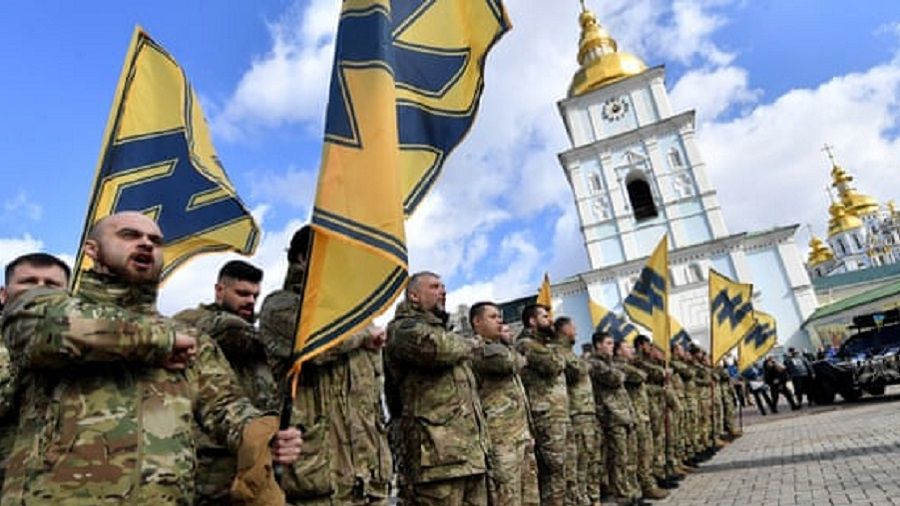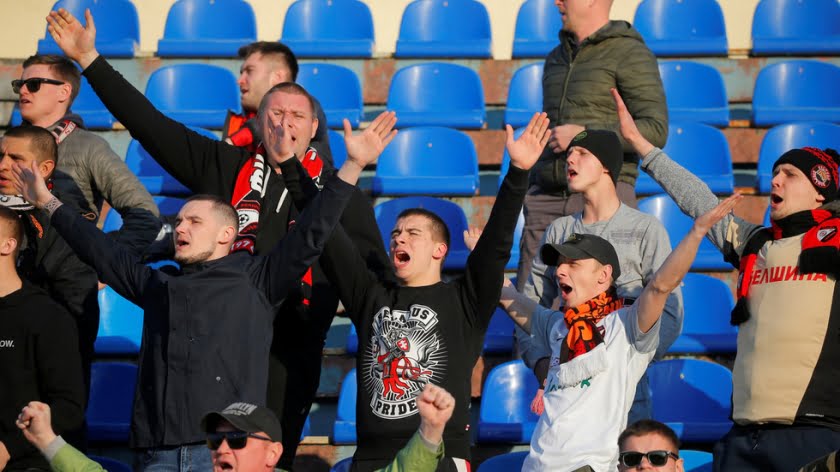Foreign Fighters in Ukraine Could Be a Time Bomb for Their Home Countries
The Misanthropic Division’s violent, hate-filled Telegram channel was the first to announce Bleriot’s death, one day earlier, on June 3. The post said that he died on June 1 in Kharkiv and included a photo in which the thin and bearded Bleriot wears a T-shirt that says “Misanthropic Division” across the front.
In 2018, the Los Angeles Times described the Misanthropic Division as “one of many neo-Nazi groups that have mushroomed throughout Ukraine in recent years.” In 2020, the Daily Beast characterized it as “the militant foreign volunteer wing of Ukraine’s neo-Nazi Azov Battalion.” The Guardian, in 2014, also said that the Misanthropic Division “is linked to the Azov battalion.” There are few other mentions of it in the news archive.
Bleriot was a “man who fought bolshevism and antifascism all his life,” according to the Telegram post, a “brother-in-arms,” who died defending Europe and Ukraine from “Asiatic hordes.” Among members of the group chat, Bleriot has become a martyr, a fallen comrade to be mourned and celebrated. One meme shows a Black Sun wheel — an icon of Nazi occultism — behind his smiling face.
Bleriot was from Bayeux, a town in the north of France. In an interview with an Argentinian reporter, uploaded to Reddit on March 3, he identifies himself as a Norman, says that he is “ready to kill Russians,” and “ready to die.” He adds that he left behind two children at home, and starts to cry. Bleriot’s family could not be reached for comment. Efforts to reach French authorities for comment on whether Bleriot was known to them were also unsuccessful.
A spokesperson for the Azov Battalion, which began around 2014 as a far-right street gang and has since evolved into a professional special operations regiment of the Ukrainian army, did not immediately respond to an inquiry about Bleriot and the Misanthropic Division. But back in April, I met with Andriy Biletsky, the founder of the Azov movement, at their base in Kyiv. I had not heard of the Misanthropic Division then, but I did ask Biletsky about foreign fighters. “We have volunteers from different countries,” he told me. “We’ve had Europeans, Japanese, people from the Middle East.” He also mentioned Belarusian, Georgian, Russian, Croat, and British volunteers. He pointed out that some of them had been Jews. However, “I can assure you that there are no Americans,” he said. “Not even western Europeans for that matter,” he added, slightly contradicting himself.
The Azov base, in the semi-industrial outskirts of Kyiv, was in an abandoned Soviet factory compound. Inside the main building, a yellow flag with Azov’s notorious Wolfsangel symbol in the center hung from the rafters. In two places, there were Black Sun clocks on the walls; such sun wheels, or Sonnenrads, also found on the floor of Heinrich Himmler’s castle in Germany, are widely used by contemporary adherents of Nazi ideology to signal their Aryan supremacist beliefs. Azov apologists say that they are merely indigenous Ukrainian symbols that must be understood in an Eastern European context. In any case, the sun wheels, backlit by blue neon, certainly lent the Azov base a neo-Nazi aesthetic. There were soldiers in full battle gear walking around, looking as squared-away and intimidating as any in Ukraine, and two women who worked as secretaries. The ground floor was full of new recruits, exclusively young white men, speaking Ukrainian and Russian.
Since Azov formed about eight years ago, it has attracted relentless controversy for its quasi-fascist ideology, unapologetically espoused by Biletsky, and alleged abuses against the few minority groups that exist in Ukraine, including the Roma. There is plenty of photographic evidence of Azov fighters displaying Nazi symbols on the battlefield (often with the intent to troll Russia). Azov has tried to clean up its image in recent years and present itself as depoliticized, and it is now an official component of the Ukrainian military, not an independent militia. But it has far more autonomy than any other regiment of the army. It presents itself as an elite corps and has attained an extraordinary degree of prestige and admiration in the eyes of ordinary Ukrainians for its stalwart defense of Mariupol, its home base, which finally fell to the Russians on May 20, following a dramatic, three-month-long siege. Although many hundreds of Azov soldiers were taken prisoner, many more young Ukrainian men have signed up to replace them.
“Azov is growing,” Maksym Zhorin, the commander of an Azov special operations unit in Kyiv, told me in April. “Our emphasis is on the future.” He added, “It might sound weird, but the actions of the Russian federation have been beneficial for us.”
As I noted in a recent piece for Harper’s, when I left the base, I saw a small group of men hanging around outside the gate, and guessed from their appearance (paramilitary attire, neck tattoos, ball caps) that they were foreign volunteers. With several Azov soldiers standing next to my translator and me as we waited for a taxi, I didn’t think it wise to approach them, but I overheard them speaking English. The one phrase I caught distinctly, over the idling engine of an armored vehicle, was “foreign legion.” Also, who knows who was responsible for it, but “WHITE POWER” was spray-painted on the kiosk right in front of us, alongside the driveway — in English, no less.
BLERIOT’S DEATH, the possible existence of more extremists like him among the ranks of Ukraine’s foreign fighters, and the rise of Azov as an internal military power should not be taken as representative of Ukraine’s society, government, and armed forces as a whole. Russian propaganda would have people believe that Ukraine and its military are full of neo-Nazis and completely under the sway of radical Russophobes. These falsehoods evaporate as soon as you set foot in the country. Ukraine does have a notably vigorous and aggressive ultranationalist sector, but even Azov, the most powerful and influential far-right force, remains a fringe movement. Ukraine is one of the biggest countries in Europe and contains multitudes. Its president is Jewish, a former TV comedian. Before Russia invaded, issues like corruption and economic stagnation were much bigger problems in the lives of ordinary people than the specter of roving gangs of fascist youths. If the Russians were really worried about neo-Nazi, ultranationalist, and white-supremacist militants, they would look in their own country, where such movements flourish as much as, if not more than, in Ukraine.
Likewise, Bleriot should not be taken as representative of the Ukrainian Army’s International Legion. Amid the chaos of the first two months of the war, most of the foreigners who flocked to Ukraine to fight were turned away and went home. The International Legion only accepted those with substantial military experience, mostly from the U.S. and U.K. Bleriot, who told an Argentinian interviewer that he had served one year in the French army, would have barely made the cut. There’s little doubt that he claimed the Misanthropic Division’s neo-Nazi ideology, as articulated in spaces like its Telegram channel, but such extremists, isolated and small in number, also find their way into the U.S. military on a regular basis.
As for the Misanthropic Division, it’s hard to tell how real it is, and how sizable. The extent of its actual association with the Azov Battalion is also unclear. Take Bleriot, for example. There’s no indication that he was with any Azov unit when he died in Kharkiv, in the northeast of Ukraine, far from Azov’s main areas of operation in the south. It may be that the Misanthropic Division is not a real-world unit with a leader and a chain of command so much as a twisted military clique that anyone online can claim.
Images readily available on the internet show young men from the U.K., France, Germany, Spain, Poland, Portugal, Brazil, and elsewhere displaying the group’s piratical-looking flag, often in conjunction with other hate symbols, and it’s possible to find photos and videos of Ukrainian soldiers, who appear to be engaged in actual combat, sporting its various badges, patches, and T-shirts. It could be a cohesive military unit made up of foreign volunteers, sheltered under the wing of the Azov Battalion, but I can find no convincing evidence, at the moment, that it is anything more than a toxic Telegram meme popularized by Azov’s most black-pilled fanboys, only a few of whom may really be serving in the unit.
The real question, when it comes to Ukraine’s foreign legion and some of the more distasteful characters that its international call-to-arms has attracted, is how much of a threat they pose to their countries of origin. The loosely organized International Legion, which may not have any central command, is limited in its ability to vet volunteers. Radical miscreants from all over the world who subscribe to the blood-and-soil ideology of neo-Nazi subcultures like the Misanthropic Division have a very real opportunity to travel to Ukraine, get military training, and participate in intense armed conflict against a technologically advanced enemy. If they survive, their combat experience could give them the confidence and ability to carry out acts of political violence in their home countries. This is clearly cause for concern at a time when incidents of hate crimes and domestic terrorism are on the rise.
In the same Facebook post of June 4 that announced Bleriot’s death, the International Legion also disclosed the death of Björn Benjamin Clavis, a German of unknown age. The photo of him shows a man who looks about 30 with buzzed hair in the uniform of Ukraine’s Territorial Defense Force. On the back of his right hand is an unmistakable tattoo of an Iron Cross, which the Anti-Defamation League describes as a “commonly-used hate symbol” favored by “neo-Nazis and other white supremacists.”
It’s possible that Clavis got the tattoo for innocuous reasons. It’s not that uncommon a symbol. The logo of the Independent Truck skateboard company, for example, looks a lot like an Iron Cross. So does the badge given out for marksmanship in the U.S. Army. However, the ADL’s analysis suggests that nonracist display of the Iron Cross mostly takes place in the United States. In Germany, where Clavis was from, it is very much associated with the Third Reich.







